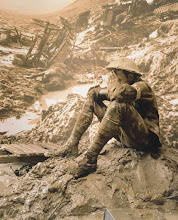The day of my Tekes Hashba'ah, the long awaited swearing in ceremony at the Kotel, was spent entirely in Jerusalem. There were so many moments. Hilarious, like when we arrived at the tayelet outlook in south Jerusalem and I identified the hotels on the skyline to my entire platoon. Annoying, as our non-native bus driver and officers proved completely clueless about how to get to the Kotel. And simply bizarre, when I proceeded to lead a lieutenant and half my company up the snake path and down to the Kotel after the officer had decided I was his best hope at arriving at the Kotel on time for rehearsals!
The heart of the day was given over to touring Har Herzl, the national military cemetery. As we started the tour, my officer asked us to consider what is more heroic: hard work, day in and day out, or the daring act, sacrificing one's life to save the lives of others. With that question on our minds, our officer then led us around the forested grounds of Har Herzl. Following the required stop at Herzl's imposing yet modest tomb, we arrived at the graves from Israel's earliest wars. The lessons to take from the plain tombstones are endless. Yigal Yadin, the chief of staff of the IDF during the War of Independence, is buried alongside a simple sergeant, both graves identical save for a few words about their rank. Israel Meir's tombstone has no parents or birthplace. The reason is simple: Israel fell shortly after arriving in the new state of Israel in 1948. Thrust into battle fresh from the horrors of the Holocaust, when he fell no records from his past could be found. All that was remembered is that he had identified as a member of Israel and such was recorded on his tomb. Yehuda Ken-Dror, the hero of the 1956 Sinai War who sacrificed his life to reveal enemy positions in the Mitla Pass, is revealed to be the younger brother of a soldier buried nearby in a common grave from the War of Independence. Yehuda, my officer noted, did not volunteer for his almost certain suicide mission out of some vain desire to be the hero. He knew the cost of a fallen family member personally.
We stopped by the graves of Hannah Senesh and her fellow group of Jewish heroes who parachuted into Nazi Europe in 1944 to save the Jews of Europe. Hannah's deeds and words have always served as one of my strongest role models. Standing at her grave hours before I would promise to "devote all my strength and even sacrifice my life... for the freedom of Israel," felt as necessary as it was appropriate.
Another visit came to the memorial to the twenty-three Palmach fighters who, like Hannah, lost their lives while fighting against the Nazis in WWII. The men disappeared on a dangerous sea mission in 1941 to blow up oil refineries in Tripoli off the coast of Lebanon. I had never heard of the mission nor the men. Making the story all the more memorable was that one of the soldiers in my platoon was a descendant of one of the men who never returned.
Our visit ended by the newest graves in the cemetery, the soldiers who fell in the 2006 war in Lebanon and the fighting this past January in Gaza. Our commander drew our attention to the graves of Michael Levine and others and then had a neighbor of Roi Klein, again one of the soldiers in my platoon, retell how Roi jumped on a grenade to save the lives of his fellow soldiers in Lebanon. As we stood on a grassy plot near these graves, our officer noted that the ground under our feet would one day be the final resting place of the next Roi Klein and Hannah Senesh, the men and women whose sacrifice would ensure the continued freedom of Israel.
Friday, January 22, 2010
Subscribe to:
Post Comments (Atom)




No comments:
Post a Comment